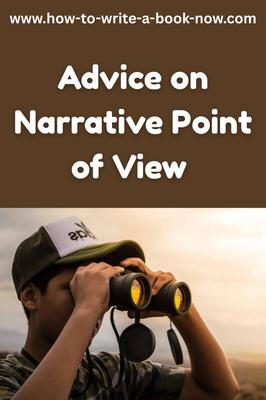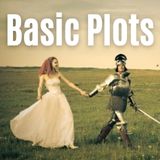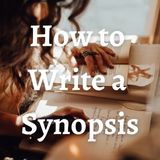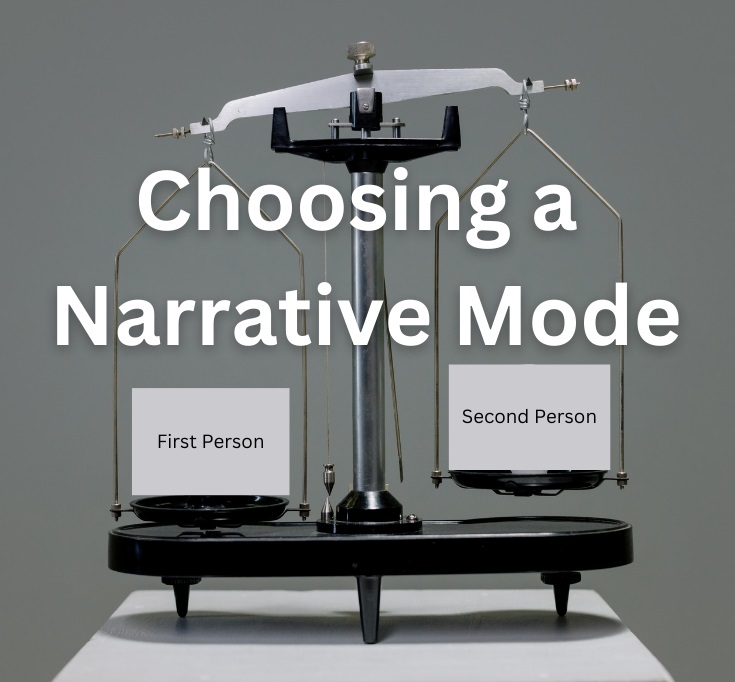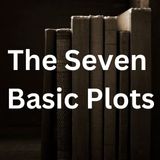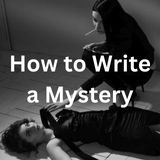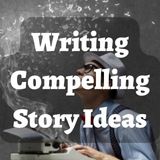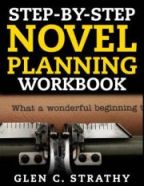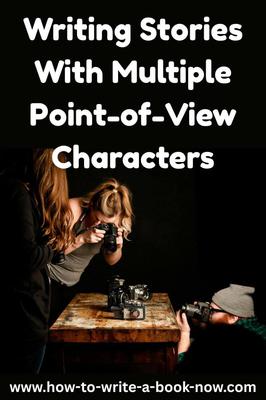Narrative Point of View
by Tracee
(Brooklyn)
Quick question about narrative point of view (POV). I started my novel in 3rd person. Just way too many characters for 1st. It is a YA novel as all of the main characters are 18 & 17. I was reading that 1st person is more popular among YA readers. But I also saw a post that said Tight Third Person was good, but its difficult. I think I have a grasp of what tight third is...I think! I'm not sure why it would be more difficult than omniscient. Any insight on this?
Thanks Tracee
Answer: It's not really difficult, but people often make the mistake of switching into omniscient narration, which destroys the illusion and the real advantage of limited 3rd person.
The advantage is that limited 3rd person confines itself to the point of view of one character. This gives the reader the enjoyment of seeing the world through that person's eyes. The readers imagine themselves as the main character. The story can feel even more intimate than first person, where the main character is "talking" to the reader. With limited 3rd person, the reader feels they are in the main character's head.
What you have to do is narrate what the main character perceives - and NOT include anything which the main character does not perceive. Nothing wrecks this style of narration faster than throwing in details the character couldn't possibly perceive, such as what other characters are thinking
With limited 3rd person, the reader is only ever privy to the main character's thoughts and feelings. What other characters are thinking and feeling can only be inferred by what the main character sees them do or hears them say. This can be fun because sometimes your main character can make false judgments about other characters, which the reader may pick up on.
(This is also true for first person, but writers are less likely to make the mistake of breaking the POV in first person.)
You can have more than one POV character within a novel (which may be necessary if you want to show the reader events the main character is not present at). But you must be very clear when you switch POVs, so the reader always knows whose head they are in. Don't switch in the middle of a scene, for instance. It is often best to only switch at chapter breaks. Try to limit the number of POV characters to as few as possible. And when you switch, give the readers enough clues right away so they can orient themselves.
While not a rule, it is often more effective, especially in YA, to have one main POV character that the reader will most want to identify with. That's simply a matter of developing that person's story more fully than that of other POV characters.
Comments for Narrative Point of View
|
||
|
||
|
||
Changing from Third Person to First Person
by Alice Magno
(Philippines)
Question: How can I change from third person to first person POV within one chapter to let the readers feel the scene?
Answer:
The short answer is I wouldn't recommend you change your narrative mode within a chapter.
Third person should not be a barrier to a reader's emotional involvement in a scene, especially if you are using third person limited narration, where you are narrating the main characters feelings, perceptions, thoughts, actions, etc.
Don't believe me? Check out some novels written in third person. See how other writers have achieved emotional involvement in a scene using this style of narration.
Of course, it could be that first person is a better fit for your story. But if that is the case, then the entire novel should probably be written from that perspective.
Don't be afraid of experimenting with different narrative modes in order to find the one that makes your story come alive. But once you have settled on the right mode, it's usually better to stick with it unless you have a strong reason not to.
At any rate, it's best not to change modes within a chapter, and definitely not within a scene. It just confuses the reader and breaks the illusion.
which person to write in
by Monica L. Stephens-Logan
(South. Charleston, OH)
A FICTION
The book is in second person but there are times when the heroine is telling a story about herself and family member. When she is telling about a family member is it correct to go back to second person? Example...
A.Maurice and Thmondi were anything but your stereotypical couple.
B.“Oh goodness,” Thmondi chuckled, a little nervous at the thought of digging up memories from her childhood. “I don’t even know what is behind all of my mood swings.
IN WHAT PERSON DO I TELL MY PARENT'S STORY IF I AM TELLING IT INSIDE OF THE NOVEL TO SOMEONE ELSE FROM HERESAY...
C.Squinting against the brazen sun Stephen flashed Rebecca a wickedly charming grin, “Woman, I know what you’re up to.
Response: I hate to break it to you, but all three of those examples you provided are written in third person. (In second person, you would be addressing the reader as "You." It's a very difficult way to write, and I don't recommend it.)
Now, if you have a character in your novel speaking, with their words in quotation, then that character will speak in first person, referring to themselves as "I." However, that does not change the fact that the book is still third person. Phrases like "she said" identify it so.
A novel written in first person would read like a letter to the reader, written by the main character. In other words, the narrator would refer to herself as "I" (without quotation marks).
I don't usually recommend Wikipedia, but in this case, its description of first, second, and third person narration may help you. Read the examples given.
http://en.wikipedia.org/wiki/Narrative_mode
which person to write in question 2
by Monica L. Stephens-Logan
(South. Charleston, OH)
Thanks for responding Glen, I gave the wrong examples. A portion of my novel is in first person when the heroine is telling her childhood experiences.
Example:We were waiting not so patiently for Mom and Daddy to come in from their heated discussion in the bed room. No one was supposed to be talking because Daddy had hollered a booming, “Sit still and be quiet until me and your mother come to the table!”
Along with those relating her own past she relates her parent's past,for example:
Stephen changed from his work clothes in silence, he half expected Rebecca to protest, he needed her to ask him to stay but she only suppressed her thoughts.
Even though this passage is in third person: the heroine is telling this about her father. It seems like the first sentence should read Daddy changed....Mom to protest. Because the heroine was not there in every situation I thought third person would be best but What is the correct person to tell Stephen's story in if his daughter is telling Stephen's story to someone else?
If that makes any sense lol.
Answer: Okay, this question makes more sense.
If your heroine is relating this story, then she is still the POV character. So I think your instinct to stay with terms like "Daddy" is correct.
The problem I have is that, if your heroine was not present for these events, how does she know enough about them to relate such intimate details? Are they stories that were told to her? How can she know what her father's thoughts/feelings were, or that her mother "suppressed her thoughts"? (Maybe you have an explanation worked out. I ask just in case you don't.) These details do not seem to fit with a child's perspective.
Even if her mother and father told her the story years later, if she is doing the telling, then it's still her POV and I would think she wouldn't be quite so certain about their inner thoughts.
I think what you're doing is mixing a little omniscient narration in with your limited POV - which is a no-no because it confuses the reader.
Of course, you could change POV characters and describe these events from the mother or father's perspective. Or you could decide to have an omniscient narrator throughout (at the cost of losing intimacy with the main character).
Or you could just stay out of the mother and father's heads and only describe what the main character perceives. (This would be my preference, but I don't know your story.)
which person to write in question 3
by Monica L. Stephens-Logan
(South. Charleston, OH)
Question: Again I thank you for your response, and yes, you've nailed my dilemma. My strong desire is to tell it from the parent's pov it reads more powerful that way but am at a lost how to do it correctly. Their story is from the past. One thing I did do was name their portion of the story after them but there is not enough substance for them to have a complete chapter name Rebecca and Stephen, or does that matter? Again thank you.
Answer: Of course, I don't know your story or how important this scene is to it, but it sounds like the kind of scene some people put in a prologue, where it can be told from a different POV.
Of course, some people don't like prologues (those who prefer to meet the main character ASAP), and prologues usually only work if they are describing the inciting incident or initial driver of the main plot.
However, you can find many successful books with prologues.
If this scene is not so important or is not the inciting incident, you have to ask yourself if the facts of it can be told in passing via exposition or if it can be cut altogether.
Again, I don't know your story well enough to give more definite advice. This is one of those painful choices writers have to make.
Deep Third Person Limited POV
by Vijay
(India)
Third person limited Deep POV is the hot topic in fiction writing and many authors have shared their knowledge in their blog. I'm trying to rewrite my first act of my WIP, and I came across the following doubts when I wrote.
1. Can a writer switch from Deep POV to normal third person within a scene? He can't be always in the character head during the pace changes (if the writer wishes to increase the pace or in the beginning of a scene).
Answer: Sometimes we are preoccupied with our thoughts and feelings. Sometimes our attention is on what's happening in the world around us, particularly if it is novel, threatening, or urgent. Some characters are more introspective than others. Sometimes we need to pay attention to what we are doing, and other times we don't. Your POV character's attention will shift similarly. So you keep your narration in tune with where the character's attention is drawn from moment to moment.
2. Can we describe every detail which character sees and hears since we are into his/her head? If so, how much detail can a author write in a scene, even though it doesn't contribute much to the plot, but may sooth reader's mind with senses?
Answer: No one takes note of every possible detail in the world around them. We notice what's important to us -- details that are significant, meaningful, novel, threatening, surprising, etc. To recreate the experience of your POV character, keep your narration focused on what the character naturally pays attention to. This can vary according to the character's particular interests. For instance, while walking down a street, an architect's attention may be drawn to features of the buildings, a child's attention might be drawn to a balloon seller, while a spy might notice the undercover policeman doing surveillance.
3. Can a narrator use POV character name when he starts a new sentence or a paragraph? Or should he just specify, He or She?
Answer: Using character names avoids a lot of confusion and is usually the best choice. It makes it easier for the reader to keep track of who is doing what.
However, there are some novels where the main character's name is concealed. It's easier to do this in first person narration, since the reader knows only one character is referred to as "I." Similarly, if your main character is the only female character in the story, you might get away with referring to her only as "she." If you're using second person narration, you might refer to the main character only as "you."
But you have to consider why you want to do this and whether it is appropriate for the story. Are you trying to portray a character with a weak sense of identity, for example?
4. Lastly, how many character POV's are suggested for a romance /family oriented novel written with Deep POV? Up to Five is Okay?
Answer: You only need one POV or main character in any story. Readers like to have a close connection with one character who they imagine themselves to be.
It is common in a romance to use two POV characters (the two romantic leads). Usually the main character is the female lead, while the male lead is the impact character and secondary POV. I suspect this is done to address the reader's anxiety about whether the man is truly the right match for the woman.
Bear in mind that each POV character is the main character of his/her own story. You may only develop one of these stories fully, and that will be the main or primary POV character's story. But some novels try to develop two or three POV characters' stories equally.
There is no hard rule about how many POV characters you can have. However, the more there are, the less of a connection the reader feels with any one character. Too many POV characters creates a kind of objectivity that makes the story feel more like omniscient narration.
I appreciate your kind response to the above questions and for your immediate and quick response to my earlier question about logical story and its repercussion on the novel.
With Warm Regards,
Vijay
mixing first and third person POV
by chynna
(Philippines)
Question: I'm just curious whether or not it's okay to mix the first person and third person POV in a novel?
Like for example, the story is about the narrator (1st person POV) leaving the country and there are really some important scenes that needs to be tackled by the other characters in the absence of the narrator. Would it be okay to write those scenes in third person POV?
Because I read that some publishers wanted writers to stick to one POV in the entire story or they will not accept it.
Thanks :)
Answer: It's pretty common for writers to switch to a different POV on occasion. In a story that's primarily told from the main character's POV, this technique may be used to create dramatic irony (where the reader finds out something the main character doesn't). Prologues and epilogues are the most common places where a different perspective is introduced.
Some stories are told from multiple points of view all the way through. In such books, each POV character is more fully developed and acts as the main character of their own story, so the book becomes more like a collection of stories that share a common, overall story.
It is true that there is a bias towards having one main character, one POV, because it makes it easier for the reader feel a close connection with one character. This is especially true in YA or children's fiction.
However, you can't be too rigid about such things. It depends very much on the requirements of your story.
Comments for mixing first and third person POV
|
||
|
||
|
||
|
||
|
||
|
||
|
||
|
||
|
||
|
||
|
||
|
||
|
||
|
||
|
||
|
||
|
||
|
||
|
||
Is changing POV between protagonist and antagonist a bad plan?
Question: My original story is completely from the POV of the protagonist. I feel that I can make the story more "fleshy" if I switch between protagonist and antagonist POV, however I am unsure if this is frowned upon by publishers and readers.
Answer: Honestly, it depends on your story. You have to weigh up the advantages and disadvantages.
Adding the antagonist's POV can increase the reader's understanding and empathy for that character. It can add depth to the character, which can be a good thing, since no one likes cardboard villains. Readers can experience a certain voyeuristic pleasure from seeing into the mind of psychopath (or just a morally corrupt person).
Another use for additional POV characters is to create dramatic irony. They give the reader a chance to learn things the main character does not, which changes or nuances the reader's understanding of certain events.
Of course, the more POV characters you have, the weaker the connection the reader has with the main character. The more POV characters, the more the reader shifts to an objective rather than subjective view of the story. Since the subjective view, based on an intimate connection between reader and main character is very appealing to readers, you have to consider the trade-off. Your thematic message may be affected by your reader's perspective on the story. (For instance, do you want your reader to identify with your main character or be in a position to judge his/her actions?)
You will see all manner of variations in published and successful books. What really matters is...
1. Do you understand and effectively connect with your ideal reader?
2. Does the style of narration fit the story you want to tell.
Switch the Point of View
by Jordan
(USA)
Question: I think I am writing my novel in limited third person but the problem is that there is one part in the story that my main character cannot witness. Is it possible to switch the point of view at one point of the story? I have read books in which this switch creates a pattern throughout the story though I prefer that this only happen once in my novel. What is the best route to go? Should I alternate or is there another way? Thank you!
Answer: You can certainly find plenty of books where what you are suggesting occurs.
An obvious example: Harry Potter and the Philosopher's Stone, which is told entirely from Harry's POV except for the first chapter (where Vernon Dursley and Dumbledore's points of view are used). As I recall, at least two other books in the series start out in a different POV as well.
It's actually fairly common to have a prologue written in another character's point of view that describes events that take place before the main character enters the story - and sometimes before the main character is born.
The value of this technique is that it lets you create dramatic irony - in which the reader knows something the main character does not.
Of course, you can bring your second POV character into the story more often, giving this character his/her own story arc, so that you are telling the overall story from multiple points of view, but it's not necessary.
Also, you shouldn't use multiple points of view unless you have a good reason, because sticking with one POV is usually more satisfying than switching.
Comments for Switch the Point of View
|
||
|
||
|
||
|
||
MC/Protag split and POV
by Fancy
(Edgewood, NM)
Question: After a long time of thinking my Main Character and Protagonist would be the same character (and written in Limited 3rd POV), I am exploring the idea that they are not as I think the protagonist would be hard for the audience to relate to. In looking for examples of this, I seem to only find books where the main character is written exclusively in 1st Person POV (Gatsby, To Kill a Mockingbird). I had not envisioned writing in that POV, and I have been unsuccessful in finding other books that I am familiar with using two characters for the MC and Protag. So my questions are: What other books (not movies) could I study that use this format, and is 1st Person POV a requirement of this format?
Thank you. Your site is really helping me get a handle on Dramatica!
Answer: You are right that, in the novel format, a main character who is not the protagonist will most often be the narrator. Consequently, these novels are written in first person, from the main character's POV.
However, there are always exceptions.
One fairly recent example - admittedly perhaps not the best - that comes to mind is The Night Circus by Erin Morgenstern.
The story is written from many points-of-view -- at least six, as I recall -- and it takes some time and effort to identify who the main character actually is. He turns out to be a farmboy who runs away to join the circus, after falling in love with one of its members.
The protagonist, on the other hand, is a magician known as the "man in the grey suit," whose goal is to defeat a rival magician in a contest of champions and who uses the circus as a setting for the contest.
As memory serves, the entire story is written in third person, present tense, limited narration.
The reason this book is not the best example is because there are so many POV characters that much of the story is not told from the main character's POV.
Perhaps some readers of this site would be kind enough to suggest other examples?
Bottom line... you are certainly free to use third person if you like when writing from the main character's POV, even if he is not the protagonist.
Comments for MC/Protag split and POV
|
||
|
||
|
||
Novice writers should avoid 1st person POV?
by Josie
(Fukui)
Question: I've begun plotting my story, intending to write it in the first person. However, today I was reading a book, Write Good or Die, in which one of the authors (David Montgomery) said novice writers should avoid 1st person POV, based on advice from thriller writer David Morrell.
In this chapter, he says:
"{1st person POV} is usually logically inconsistent- why is this narrator taking the time to sit down and pen a 300 page account of his/her life?" This is a realistic complaint, but one that never occurred to me when reading 1st POV novels. He goes on to say: "If you're going to do it, you better have a damn good reason and you'd better know what you're doing. ... most first person novels could be improved by a shift to the third person. {It} should only be done with great care by the writer, and only when the story demands it. ... Third person limited is the most often used POV and is the best choice for most stories."
I found this disheartening. I was hoping to write my story in first person because my POV character is experiencing a slightly distorted reality because of her mental affliction.
What do you think? Do you agree that 1st person POV should be avoided by novice writers?
Answer: Not all writing advice can be applied to all types of stories. You have to discern what is helpful and applicable to the story you are writing.
It's true that third person limited is the most common narrative mode and often the easiest. Stories where the emphasis is on external action (thrillers are one example) rather than the main character's inner conflict are more likely to be written in third person.
First person is a more intimate style that allows you to give the reader a more closer look inside the main character's head -- at her thoughts, feelings, and perceptions. As such, it is more often used in thrillers with a psychological component (e.g. The Girl on the Train), in which the main character's grip on reality or sanity is uncertain or in which you want the reader to doubt the reliability of the narrator. In other words, the kind of book you are writing.
Of course, psychological stories can be more challenging, especially for writers whose natural instinct is to write external action. Making the character's voice authentic in a psych. thriller takes a different type of skill. On the other hand, some writers seem to be instinctively better at writing a character's inner life than external action. You may be one of those writers; I don't know.
As for finding a logical reason why a first person narrator is recording their life story in a book, it's really not that hard. Lots of people write their life story -- sometimes in diaries, sometimes when they are retired. Often they do it to give to their children. First person narration in past tense resembles a person sitting down with a friend and telling them their life story.
On the other hand, how do you explain a third person narrator? Who is this entity who knows everything about the story world and manages to give a first-hand account of all the events but is not actually present for any of them? Or, if the narrator is actually the main character, why is she writing about herself in the third person?
Bottom line: if you have a strong feeling for how you should tell your story, don't let yourself be talked out of it by a book. Trust your instincts and the fact that you may not be writing the same type of book as the author whose advice you are reading. Maybe you should seek out advice from people who write the kind of books you like to.
At the same time, be willing to experiment with different narrative modes in order to find the one that your story come alive for you.
Best of luck.
POV and Tense
by Tara
(New Zealand)
Question: My question is about POV and tense. I'm trying to write a story about an adventure that happens to four people. One person is basically the protagonist, and I've been writing them in first-person/present tense.
However, I also want to write about the other characters and since they aren't the protagonist, they're written in third-person, but its easier to write them in past tense as well, instead of present tense. There's lots of info on switching POV and switching tense, but not really switching both at the same time.
I was wondering if it would be considered acceptable to switch from first-person/present tense to third-person/past tense when switching between the protagonist and the other three characters?
Answer: I think it's important to consider why you would want to change from present to past tense. Does it add anything to the story?
You might try writing your protagonist's perspective in past tense and see how it feels reading it back.
You want to find the narrative style that makes the story come to life in the most valuable way.
Of course, you should not change narrative mode or point-of-view within a scene.
That said, if you consistently switch between two modes, first person present and third person past, that may help the reader distinguish the protagonist from the other three characters.
Best of luck.
Should I write in 1st person or 3rd?
Question: I do not have much experience in 3rd person POV, but it seems a bit harder because you have the limited and omniscient types. The majority of novels nowadays are being written in 1st person POV (e.g. The Hunger Games, Lorien Legacies...). So should I write in 1st person or 3rd?
But the thing is, that I'm writing a fantasy novel, and I realised that all famous fantasy novels are written in 3rd person POV (e.g. Harry Potter, The Hobbit, The Lord of the Rings..).
Which one shall I choose?
By choosing the 1st person POV I have the choice of changing narrators, and even write in present tense.
THANK YOU FOR YOUR RESPONSE & TIME.
Answer First, the reason so many fantasy novels are in third person is because most novels of all genres throughout history have been written in third person. First person has become more popular in recent years in young adult books, but third person is still quite acceptable.
Third person, omniscient narration has fallen out of popularity, in place of third person, limited, which is now the gold standard of narrative modes.
I believe the shift away from omniscient shows that readers have become more interested in subjective rather than objective accounts, which also explains why first person narration has become more popular, and why use of present tense is also on the rise (in present tense, the narrative voice has no objective understanding of the history of the events).
I should point out that it is perfectly possible to use present tense when writing in third person, limited, and to use multiple point-of-view characters.
However, you are also free to use first person narration in fantasy, if that creates a more interesting voice.
You should never feel that you have to slavishly follow the example of books that have come before. Readers and fans of a genre do carry certain expectations, but they also have a desire to see fresh, new approaches as well. It's how you balance the two that matters.
The only way to be sure what style of narration you should use is to write a little in both styles and see which one makes the story come alive for you the most.
Second POV Character?
by Rochelle
(USA)
Hello and thank you to everyone and anyone who answers my question! Here it goes...
I've written a novella in the deep 3rd person pov of one character. My story has two main characters who eventually share a love interest. The female character is a pretty angry person whose negativity is counterbalanced by the male character's personality. The entire story is written in the female's pov. I really want this story to be novel length and feel that I could add more depth to the story by adding the male's pov. I'm afraid of pulling the interest of the reader away from my female character by adding the pov of a much more likeable character. Any thoughts or suggestions?
Answer: Obviously you understand the need to develop rather than pad. Material you add should explore themes/subjects in a way that complements the existing material and adds interest.
When you switch to another POV character, you are essentially creating another storyline, since everyone is the hero of their own story. That implies the need to develop the man's inner conflict, which may have been invisible before.
Usually in romances, each of the two lovers is the impact character to the other. When in the woman's POV, the man should provoke her inner conflict by showing her a different approach to take toward problems. In the man's POV, the woman will provoke his inner conflict by showing him a different approach in regards to a different but complementary issue. In this way, each promotes the other's growth.
Typically, if one of these characters is a holistic thinker, the other will tend to be a linear thinker. This is why each can offer the other a different perspective.
So you might look for some issue in the man's life that he is struggling with. Give him a personal crisis where he must decide whether to stick with his usual approach or switch and adopt hers. (Presumably you have already given her such a crisis in which she must decide whether to take his approach.)
You may find it helpful to map out the four throughlines (main character, impact character, relationship, and overall). More info on this here...
https://www.how-to-write-a-book-now.com/writing-an-outline.html
But remember that, with two POV characters, you may have two main character and two impact character throughlines (therefore more material).
Finally, any event (significant change) in your plot may be told as one scene with the following dramatic structure...
setup --> complication --> crisis --> resolution
... or it can be developed into a sequence of scenes where each part is a scene in itself.
Here's more on how to do this...
https://www.how-to-write-a-book-now.com/length-overall-where-to-add.html
Of course, not every event must be turned into a sequence. You have to play around with this technique in order to discover which events can productively be developed and which are better off as they are.
However, the advantage of turning events into sequences is that every event in your expanded story will be part of a dramatic arc that comprises an important development in the story. In other words, no mere padding.
Best of luck.
Comments for Second POV Character?
|
||
|
||
Point of View of a Dream Character
by Greg
(Charlotte)
Question: I've been working on a story for about a year, a little bit here, a little there. This is my first attempt at a novel. I'm about 20,000 words in and up until today I wasn't sure where the story was ultimately going. My question is this: can my protagonist, who is also the narrator be a character who technically only exists in the dreams of another person? Can I write from the point of view of a dream character? And if the story teller doesn't actually exist in the real world, how can his story be told in first person? Please help!
Response So who's telling the story, the protagonist or the dreamer? Whoever it is will be the one the reader is most likely to identify with and see as the main character.
You have to choose whether you are writing a story about a man who discovers he is only someone else's dream, or about someone having a dream about a man. Whose inner conflict will the reader be privy to or relate to the most?
One clue: whichever of these two must make an important choice at the climax that determines the outcome of the story will be your main character.
If the protagonist is the main character who is telling the story to the reader, then he will be the "I." If the dreamer is narrating the story about the protagonist, he will use 3rd person most of the time, only using "I" on occasion when referring to himself.
Of course, the other possibility is to make both these characters point-of-view characters and change points of view now and then.
One thing is certain: you can't have "I" refer to more than one person at a time. Readers need to know whose head they are in at any given moment.
Regarding your question whether such an arrangement can be done, one similar example that springs to mind is the film The Neverending Story, in which the main character reads a book about the protagonist and most of the film's action is the protagonist's story.
Comments for Point of View of a Dream Character
|
||
|
||
|
||
First Person POV - How to "tell"
by Ann Marie
(Phoenix, AZ)
Question: I am writing my first novel in a series and I have been writing in the first person POV. Or at least I thought I was until I had another (new) writer friend of mine read my first 3 chapters for feedback.
In the first chapter, I have my main character explaining a lot about her past, as if she is telling her story. I believe that these are things the reader will need to know in the beginning so that they will not have confusion on who the characters are to each other, and a better understanding of why the character is trying to find a way out of the state and away from her destructive parents. Is it ok for her to "tell" here and not show? Or is the only way for a POV to "tell" in first person in dialogue?
Answer: The challenge you face is that too much telling, especially in the beginning chapters, tends to create distance between the reader and the actual events that are being described. Readers don't just want an account of what happened. They want to feel like they are there, as if they are the main character experiencing the story.
Sometimes you just need to balance telling with showing. In first person, the main character can tell the reader little bits of information interspersed within a scene that is being shown. This often work better than long passages of exposition which can disrupt the flow of action.
If there are key events in the past that you feel your reader needs to know, you might consider using flashbacks, so that you can show those events.
Another option is to start the story earlier - perhaps with an event that shows the parents' destructive nature from the main character's POV.
In fact, you should ask yourself why you are not starting with that event. It sounds like it is the initial driver of your story.
Usually, you would hide the initial driver if you want to create a mystery - i.e. make the reader wonder why the character has left home. If you don't want a mystery - if you feel the reader should know about the event upfront - then why not start there?
There are times when telling is preferable to showing, such as when you just want to transition from one key event to the next. Just make sure the reader has enough showing in the beginning to forge a close connection to your main character.
Comments for First Person POV - How to "tell"
|
||
|
||
|
||
main characters and POV'S
by Tori S
(surprise, AZ, USA)
Question: I'm wrestling with main characters and POV's and I've been reading through the articles here (which I might add are the best things I've stumbled upon thus far) and have been giving it a go to fixing a story I wrote a few years back.
I've read through a lot of the questions that people had to help answer some of my questions before asking one so here's my attempt to ask a question that will hopefully settle everything.
I plan on writing a series (about 3-4 books) and at first I was confused about the story goal and plots (mainly because I was thinking of the first book not the whole story in general) and now that that's cleared up I'm still lost on how to pick my main character/POV in general.
The story starts with girl trying to find out a secret that was hinted to her by the antagonist of the first book and I originally wanted it to mainly be in her POV with few POV character changes to help the story along. But after many weird drafts and reading here I've been wondering if I should make the POV in her closest friend POV seeing as he knows the truth about everything and his character story seems to have more going on. However to write in his POV would give out the big over all secret that I intend to reveal later in the book.
I guess my question is how to integrate both of them together because eventually she does find out and becomes a part of his world.
Also, would it be best to write in third person for this? Because it seems kind of hard to be in third person without wanting to go back and have it first person. It feels like there's less of a connection with the characters. However when I write in first person it feels too repetitive to state I (even though you have to) and not all the characters feel equally developed in their descriptions around them.
Lost writer for some years,
Tori
Answer: From what little you've said, it sounds as though your main character is the girl, for the first book at any rate. Since the reader does not know your story world, her path of discovery would parallel the reader's. It would particularly make sense if discovering the secret is also the story goal for this book, in which case she may be the protagonist.
In later books, it may be possible for you to make the best friend the protagonist - if he is such a major character - and still tell his story from the point of view of the girl, if you choose.
If you are telling the story from multiple points of view, keep in mind that can essentially mean having multiple stories within one novel. Or you can have several main characters, each with their own throughline, who essentially share an objective story throughline. Any of the major POV characters will need his/her own inner conflict and character arc. (If you've ever read the Bartimaeus trilogy, you'll recall that series has three POV characters, each with their own arc, whose paths cross, and who share the overall throughline.)
I can't help wondering who your impact character is. Perhaps the friend? Typically, male/female relationships make good main character/impact character relationships - as is the case in most romances, The X-files, etc. Sometimes, when you are writing from both points of view, each is the impact character to the other.
As for which person to write in, 3rd person is usually easiest when dealing with multiple POVs, because using names helps the reader know whose head he is in at any moment. However, if you want one of your POVs to stand out as the real main character, you could use first person for that character only.
Best of luck.
- Home
- Writing Questions
- main characters and POV'S
